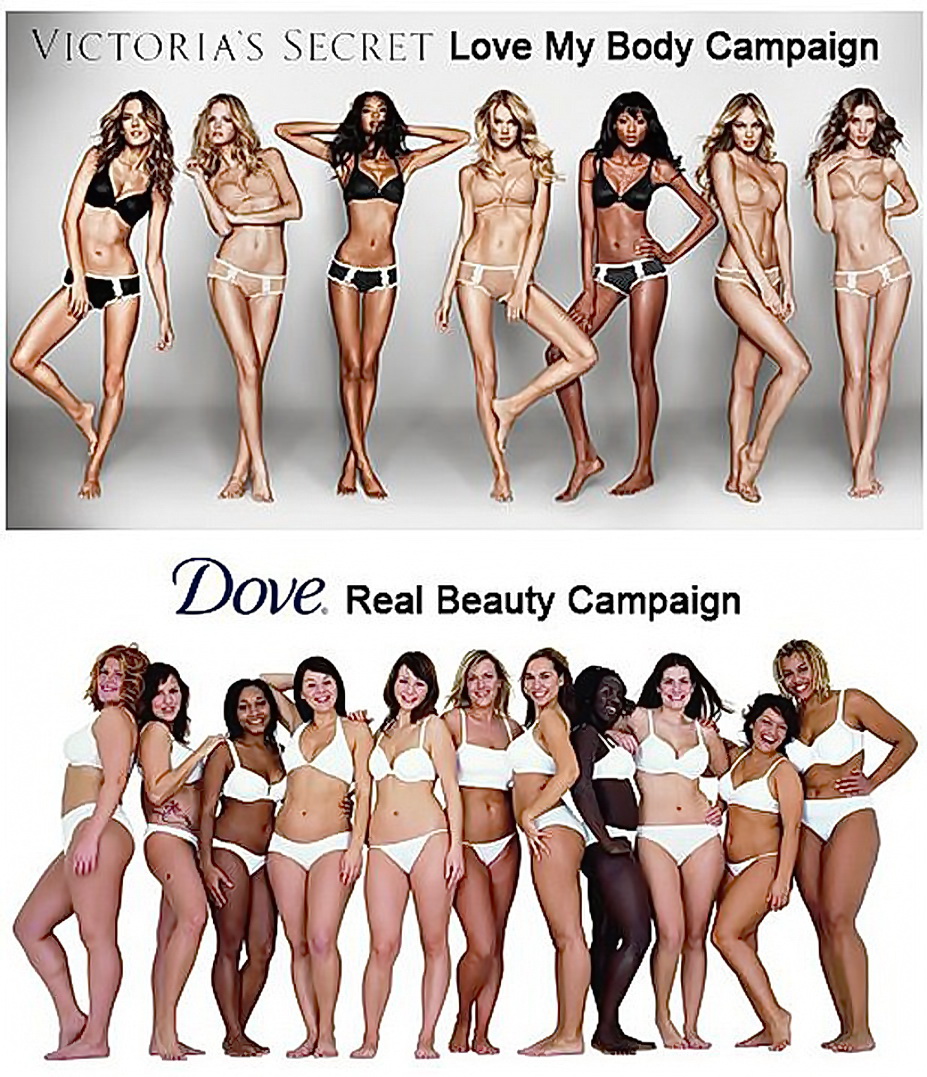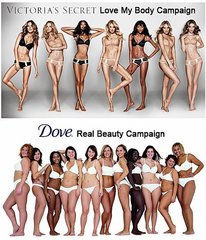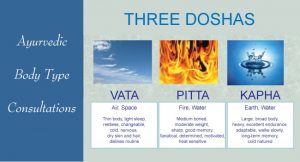As the hype continues after the recent catwalk shows, the Victoria secret angels have been doing Pilates Reformer, Yoga and Barre to stay in shape. But can doing these pastimes really give you the catwalk body that you may desire ? As i embark on another cadaver study this week, this re-affirms the thinking we are only as good as the quality of our tissues. “75% of an individuals health after age 40 is dependent upon what the person has done to his or her genes, not to the genes themselves.”- Jeffrey S. Bland, Ph.D Genetic Nutrition.
Our tissues are dependent on a number of factors including breathing, sleep, stress – physical ,hormonal & chemical, nutrition, hydration, fungus and parasites and movement. Observe the post of the supermodels and the Dove real women comparison below.
Ectomorph, Mesomorph, and Endomorph. Many people think that “body type” just describes the way a person looks, but your body type can also provide information about how you respond to food intake and your hormonal and sympathetic nervous system (SNS) characteristics. These factors can be linked to metabolic differences between individuals, and influence how you respond to diet and training. Understanding your body type will help you to strategically & successfully plan your strength training and diet regiment, and once you establish your body type, you can adjust nutrient intake to maximize fitness composition and health related goals. “To achieve results never before obtained, we must attempt methods never before tried.” – Sir Francis Bacon
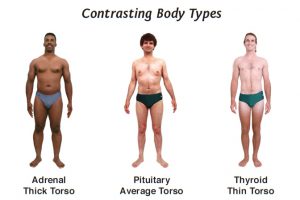
Very few people fall perfectly into one of the three categories, and are often a mix of the 3 characteristics. Also, training along with good nutrition can completely change the appearance of one’s body. One important thing to remember is that regardless of your
body type, composition, or overall health status, your ability to handle carbohydrate-dense foods is greatly improved during and after exercise, meaning that the best time to eat the majority of starchy/sugary foods is around the times that you’re physically active. Depending on your body type, your carb tolerance is different and your strategy should be different.
The Three Body Types:
Ectomorph – Sympathetic, nervous, priestly class, endurance sports, favour carbs.
Mesomorph – Syrup, para, warrior class, aggressive, combat sports, favour animal foods.
Endomorph – Parasympathetic, administrator, slower, ritualistic, more relaxed, mixer.
So what should you be eating ? –
The History of Metabolic Typing
In the 1930’s, dentist Weston Price began expeditions around the world and uncovered the link between modern eating habits and chronic degenerative diseases. He studied the differences in diet composition in different indigenous communities.
He wanted to find out why these indigenous cultures and the specific composition of their nutritional intake, (diet), often made up of either high carbohydrate or high protein content and the fact that their specific diet created such healthy individuals with the low rates if any of chronic degenerative diseases and illness.
In many of these cultures cancer, heart disease, diabetes and other chronic illnesses were generally unheard of. He also discovered that there was no one diet that would be healthy for all people — there was too much variation in climate, local produce, environmental conditions, heredity, genetics, culture.
In later years, George Watson, Roger Williams, William Kelley, and others continued research in this area. They all realised that all people were different in the nutritional needs for each individual. They also found that for a cell to function at optimal health and operation it needed to be fed the correct balance of nutrients that are right for the persons Metabolic Typing.
How can I find out my metabolic type?
In the book The Metabolic Typing Diet, researcher William Wolcott offers a simple home self-test for identifying your metabolic type. For an accurate diagnosis, a trained health practitioner can provide a thorough assessment that may include urine and blood tests. Metabolic typing is dependent on:

- Racial / Ethnic background
- Biochemical Individuality
- Macronutrient Proportions
- Oxidisation rates
- Macronutrient needs
- Food Quality and preparation
Wolcott provides three general metabolic types:
Protein types — Protein types are fast oxidizers or parasympathetic dominant. They tend to be frequently hungry, crave fatty, salty foods, fail with low-calorie diets, and tend towards fatigue, anxiety, and nervousness. They are often lethargic or feel “wired”, “on edge”, with superficial energy while being tired underneath.
Carbo types — Carbo types are slow oxidizers or sympathetic dominant. They generally have relatively weak appetites, a high tolerance for sweets, problems with weight management, “type A” personalities, and are often dependent on caffeine.
Mixed types — Mixed types are neither fast or slow oxidizers, and are neither parasympathetic or sympathetic dominant. They generally have average appetites, cravings for sweets and starchy foods, relatively little trouble with weight control, and tend towards fatigue, anxiety, and nervousness.
What are the guidelines for the diet?
According to the metabolic typing diet, the three metabolic types should eat the following foods:
Protein types should eat diets that are rich in protein, fats and oils, and high-purine proteins such as organ meats, pate, beef liver, chicken liver, and beef. Carbohydrate intake should be low.
Carbo types should eat diets that are high in carbohydrates and low in protein, fats, and oils. They should eat light, low-purine proteins.
Mixed types should eat a mixture of high-fat, high-purine proteins and low-fat, low-purine proteins such as cheese, eggs, yogurt, tofu, nuts. This type requires relatively equal ratios of proteins, fats, and carbohydrates.
What are the strengths of this diet?
Unlike other diets that recommend the same plan for everyone, the metabolic typing diet recognizes that we are individual. Our metabolisms differ, so our diets should as well.The metabolic typing theory may help to explain why some people do better on a high protein, low carb diet, while others do better on a high carb diet. Wolcott explains that the effects of different diets on the metabolic types:
High Carb, Low Fat Diet — This diet is suitable for carbo types. However, in protein types and mixed types, a high carb, low fat diet can increase fat storage by increasing insulin, and lower metabolic rate by breaking down muscle tissue due to insufficient protein intake, and may disrupt adrenal and thyroid function.
High Protein, High Fat Diet (e.g. Atkins Diet) — This diet is suitable for protein types. However, in carbo types and mixed types, a high protein, high fat diet can increase fat storage by disturbing cellular oxidation, and lower metabolic rate by creating a shortage of glucose caused by low carb intake. It may also disturb adrenal and thyroid function.
40-30-30 Diet (e.g. Zone diet) — This diet is suitable for mixed types. However, a 40-30-30 diet can increase fat storage by disturbing oxidation. It can lower metabolic rate by creating a shortage of glucose in carbo types and a shortage of protein in protein types, both resulting in muscle breakdown.
What does Yoga say ?
Yoga dietary advice tends to be heavily influenced by Ayuverda, in which diet is the centrepiece of strategy. From an Ayuverdic perspective, the right foods for each constitutional type can be grouped by taste. Pittas, according to Swami Shivananda, a dutch physicist turned Yogi and Ayurvedic practitioner , should choose mostly foods with bitter, astringent and sweet tastes. vatas should favour foods that our sweet, salty, and sour. Ideally, kaphas should eat foods that our spicy, bitter or astringent. Bitter foods include broccoli rabe and most leafy greens. Sour or acidic tastes include lemons, limes, yoghurt and kefir. Examples of astringent foods are asparagus, artichokes, sprouts, potatoes, and pomegranate. In Ayuverda , sweet refers to naturally sweet foods such as fruit, not refined sugars, which are frowned upon in excess.
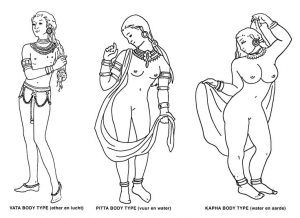
As with Yoga practices people are often drawn to may not whats best for them. Pittas often like spicy foods, which increase their fire. Ayuverda recommends vatas eat warm foods that our smooth in texture to calm their restless minds, but they often prefer corn chips, sales and granola. Kaphas often love sweet and rich desserts, but the can exaggerate their tendency towards weight gain. The swami points out that you don’t need to avoid less favoured foods entirely, but simply recognise that an access could put you out of balance. “Because we cannot scrub our inner body we need to learn a few skills to help cleanse our tissues, organs, and mind. This is the art of Ayurveda.” Sebastian Pole

